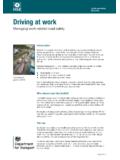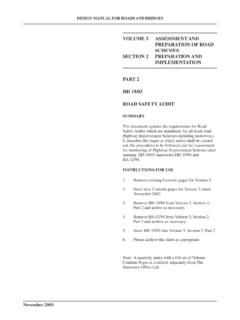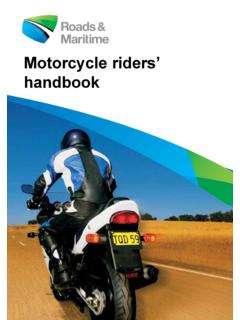Transcription of NEW ROAD SAFETY LAWS: PROGRESS TO DATE - who.int
1 SECTION 2 NEW road SAFETY LAWS: PROGRESS TO DATE Encouraging a culture of safe road behaviour that in turn achieves sustained reductions in road traffic injuries requires persistent attention. Nonetheless, many countries have, within a relatively short timeframe, implemented and enforced effective legislation to reduce speeding and drink driving, and increase use of motorcycle helmets, seat-belts and child restraints. Sustaining high levels of enforcement and maintaining a high perception of enforcement among the public are essential to the success of such legislative measures (4). This report shows that road SAFETY legislation has been strengthened in 35 countries, representing almost 10% of the world s population.
2 These countries passed laws to address one or more key risk factors affecting road traffic injuries and fatalities speed, drink driving, motorcycle helmet use, seat-belts, and child 94 countries now have national laws that address all five key risk factors to some degree, there has been no increase since the end of 2008 in the number of countries with comprehensive laws covering all five risk factors: only 28 countries (with just 7% of the world s population) have comprehensive laws in all five areas (see Figure 12). Of these 28 countries, only four (Estonia, Finland, France and Portugal) also rate their enforcement of these laws as good ,1 showing that much more work is needed to ensure the effectiveness of these Defined as 8 or more on a scale of 0 to 10.
3 See Explanatory Note 2, page coverage of comprehensive legislation that addresses all five key risk factors has stalled since 2008. Unless the pace of change is accelerated, the United Nations General Assembly target of having 50% of countries with comprehensive legislation by 2020 will not be road SAFETY laws have been passed in 35 countries but only 7% of the world s population is covered by comprehensive legislation for all five risk factors. Figure 12 Increase in the percentage of world population covered by comprehensive legislation on five key road SAFETY risk factors since 2008 Percentage (%) of world s population6050403020100 HelmetsSeat-beltsAll five risk factorsDrink drivingChild restraintsSpeed908070 2008 201112 GLOBAL STATUS REPORT ON road SAFETY , 2013 PROGRESS to reduce excessive speed has stalledSpeeding is a major road SAFETY problem in all countries.
4 Faster driving speeds increase the likelihood of a crash occurring, and the severity of the crash consequences. Interventions to reduce speed can lead to significant reductions in road traffic injuries. In urban areas, with high concentrations of pedestrians and cyclists, measures to reduce speed are critical to the SAFETY of these road users. Excessive speed is a worldwide problem affecting the entire road network (motorways and highways, and rural and urban roads). Speed limits vary by road type and most of the best practice identified in this area has come from REDUCING SPEED high-income countries (4, 14). At present, even in high-performing countries, there is diversity in speed limits used for particular road types, but most countries follow a hierarchical approach and adopt speed limits within the following levels: Higher speed roads: motorways, expressways and multi-lane divided highways ideally ensure no contact between motorized and non-motorized traffic and have barriers to separate opposing directions of traffic.
5 In general they have the lowest rates of road injuries because of these features. In most high-income countries, speed limits are set at between 90 130 km/h. Rural roads: single lane carriageways in rural areas include many different types of roads, and speed limits in high-performing countries vary from 70 100 km/h. These roads have much higher rates of injuries than higher speed roads, because of large differences in speed between various types of user. However, the wide range of definitions used to classify rural roads, and the fact that their speed needs to be adapted to different circumstances along the length of rural roads, makes it difficult to compare rural road SAFETY across countries. Urban roads: roads in towns and cities are usually shared by pedestrians, cyclists, users of public transport as well as higher speed traffic.
6 While 50 km/h is considered best practice for urban speed limits, there is much 13 SUPPORTING A DECADE OF ACTIONN ational urban speed limits 50 km/h and can be modifiedNational urban speed limits 50 km/h and cannot be modifiedUrban speed laws at subnational levelUrban speed laws not comprehensiveData not availableNot applicableevidence to support reducing these limits to 30 km/h as a way of traffic calming in areas with high pedestrian concentration. However, achieving this requires local authorities to have the authority allowing them to reduce speed limits that are set at a national level. Reducing urban speeds protects pedestrians and cyclists Setting speed limits according to the designated function of particular roads is an effective measure to reduce road traffic injuries.
7 A number of countries considered leaders in road SAFETY , such as Australia and Sweden, have adopted universal urban speed limits of 50 km/h, based on the effectiveness of this measure in reducing injuries and deaths. Although well over half of all countries (114) apply this urban speed limit, these countries represent less Figure 13 Urban speed laws by country/areathan half (47%) of the world s population (see Figure 13). Between 2008 and 2011, six countries improved their urban speeding laws, protecting an additional 246 million people, but more effort is needed to encourage governments to adopt maximum urban speed limits of 50 and cyclists are especially at risk of an injury as a result of excessive vehicle speeds.
8 This vulnerability means particular attention needs to be paid to speed limits in areas with high concentrations of these road users, such as around schools or in residential neighbourhoods (4, 14). Traffic calming measures that reduce vehicle speeds in these areas are proven effective in reducing road traffic injuries. For example, introducing 30 km/h zones in residential areas in the UK resulted in overall vehicle speed reductions of 15 km/h and cut vehicle crashes with child pedestrians and cyclists by 67% (15). However, nearly half of all countries (82) lack enabling legislation that permits local authorities to modify national speed limits, thus limiting the ability of subnational governments to implement effective road SAFETY measures within their jurisdictions.
9 This is further reflected in the low proportion of countries (37%) that have urban speed limits of 30 km/h or less around together, this means that just 59 countries both implement national urban speed limits of less than or equal to 50 km/h and allow local authorities to further reduce these limits where appropriate. These countries represent billion people, or just 39% of the world s STATUS REPORT ON road SAFETY , 2013 Speed limits need stronger enforcementAlthough most countries have enacted national speed limit laws, their enforcement is often lacking: only 26 countries rate enforcement of their national speed limits at good (8 or above on a scale of 0 to 10). Even in high-income countries, which tend to have more financial resources to dedicate to enforcement, speed law enforcement remains weak, with only 20% of high-income countries reporting good enforcement.
10 Enforcement of speed limits is essential for successfully developing safer driving behaviour and needs to be given increasing emphasis in most countries. Only 59 countries, covering just 39% of the world s population ( billion people), have implemented an urban speed limit of 50 km/h or less and allow local authorities to reduce these A DECADE OF ACTIOND rink drive laws should be based on blood alcohol concentration levelsDrinking and driving increases the risk of being involved in a crash, as well as the severity of resulting injuries. Driving starts to be impaired at very low levels of alcohol consumption, with the risk of crash involvement growing rapidly as consumption increases. The vast majority of adult drivers are affected or impaired with a blood alcohol concentration (BAC)1 of g/dl, while at a BAC level of g/dl the crash risk is approximately five times higher than that of someone with a BAC level of zero (16, 17).















